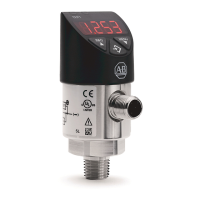
Do you have a question about the Rockwell Automation Allen-Bradley 836P Series and is the answer not in the manual?
| Product Series | 836P |
|---|---|
| Manufacturer | Allen-Bradley |
| Category | Switch |
| Input Voltage | 24V DC |
| Enclosure | IP67 |
| Adjustable Range | Varies by model |
| Voltage Rating | 24V DC |
| Ingress Protection | IP67 |
Provides critical safety alerts like WARNING, ATTENTION, and IMPORTANT notices.
Explains the meaning of various hazard labels (Shock, Burn, Arc Flash).
Provides an introduction to the manual and the product's advantages.
Defines abbreviations and key terms used throughout the manual.
Lists other documents and resources for further information.
Explains the fundamentals and purpose of IO-Link technology.
Details the advantages and benefits of using IO-Link.
Discusses how IO-Link integrates smoothly with existing systems.
Covers monitoring machine status and predictive maintenance through IO-Link.
Explains how to monitor sensor operational status and troubleshoot issues.
Describes storing and automatically applying device configurations.
Explains using intuitive tag names for easier data access and troubleshooting.
Details the communication mechanism and data transfer in IO-Link.
Lists the specified communication rates for IO-Link devices.
Explains the voltage level and error handling in IO-Link communication.
Discusses factors affecting the system's response time and cycle times.
Identifies the four types of data exchanged via IO-Link: Process, Value, Device, Events.
Explains how to access data via Cyclic and Acyclic methods.
Outlines the initial steps for establishing IO-Link communication.
Details how device parameters are defined and managed using IODD files.
Highlights Rockwell Automation's integrated solutions for IO-Link.
Summarizes specific features of the 836P sensor with IO-Link.
Lists the required hardware components for IO-Link setup.
Lists the necessary software applications for configuration.
Provides a practical, step-by-step example of hardware connection.
Guides users on creating a new project in Studio 5000.
Explains the process of installing the Add-on Profile for the IO-Link module.
Details the steps to configure the IO-Link master module in the software.
Outlines the steps to register the IODD file for the 836P sensor.
Describes how to physically connect the sensor to the IO-Link master.
Introduces the purpose and benefits of Add-on Profiles.
Provides step-by-step instructions for installing the AOP.
Explains how to set up message instructions for communication.
Demonstrates reading data from the sensor using message instructions.
Details the process of retrieving specific data from the sensor.
Shows how to write data, like the Application Specific Name, to the sensor.
Explains how to verify that data has been successfully written to the sensor.
Provides links and information for accessing technical support.
Offers a channel for users to provide feedback on the documentation.